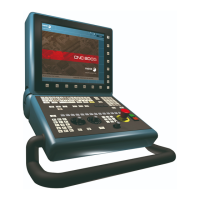




Do you have a question about the Fagor CNC 8065 and is the answer not in the manual?
| Brand | Fagor |
|---|---|
| Model | CNC 8065 |
| Category | Control Systems |
| Language | English |
Explains the procedure for powering the CNC on and off, including startup options and considerations.
Provides an overview of the CNC interface elements: status bar, work mode windows, and softkey menus.
Explains the various icons and information displayed on the CNC status bar.
Describes how to access operating modes and their relationship with channels.
Explains how CNC warnings and errors are displayed and managed, including error categories.
Covers selecting programs, setting execution blocks, and executing programs.
Explains how to recover program history and execute blocks, including automatic and manual search.
Details the tool inspection process, including manual calibration and repositioning axes.
Covers operations like home search, jogging axes, and moving axes to specific positions.
Details manual tool calibration using a reference part without a probe.
Explains semi-automatic calibration using a tabletop probe.
Describes automatic calibration using a probe and canned cycle for mill or lathe models.
Outlines prerequisites for part centering, including probe calibration and placement.
Details the data required for part centering, including probe data, movements, geometry, and dimensions.
Describes the EDISIMU mode interface, including windows, status, and program information.
Covers program editing, available modes, and the process of simulation.
Describes the editing window, its functionalities, and error handling.
Introduces HD graphics for part-program execution and simulation.
Explains HD graphics display during automatic mode execution.
Describes HD graphics display during program simulation in EDISIMU mode.
Describes the graphic environment for lathe operations, including display and dialog areas.
Explains how to edit, modify, and execute individual blocks.
Introduces user tables, including zero offset, clamp, global, and local parameter tables.
Describes absolute, incremental, and PLC offsets, and their table structure.
Details common, global, and local arithmetic parameter tables.
Introduces the tool table, active-tools table, tool change status, and tool magazine tables.
Describes the tool tables (full mode and simple mode) and their functions.
Defines tools and their associated data, and how they are distributed in magazines.
Shows the Utilities mode screen layout, including folder tree and file list.
Explains how to set protection passwords for CNC functions, PLC, and machine parameters.
Covers making backups and restoring CNC configuration data.
Describes the PLC mode interface, including service, data, status, and message windows.
Covers managing PLC projects and their files, including editing and monitoring.
Details program editing in C or mnemonic languages, including hotkeys and softkey menus.
Explains editing in contact (ladder) language using softkeys and hotkeys.
Describes how to monitor PLC programs, including monitoring windows and softkey menus.
Details editing PLC messages and errors, including file management and display.
Describes the oscilloscope as a tool for adjusting CNC and drives, showing variables and parameters.
Explains the Bode diagram as an assistance tool for adjusting CNC and drives.
Details the circularity test for improving and adjusting axis reversal peak.
Describes the DDSSetup mode interface for setting up digital servo systems.
Details how to edit parameters and variables for Sercos drives and Mechatrolink servos.
Shows the diagnosis screen layout, including hardware/software configuration and messages.